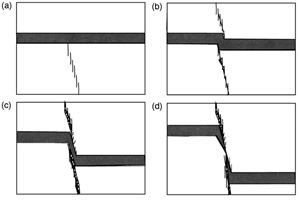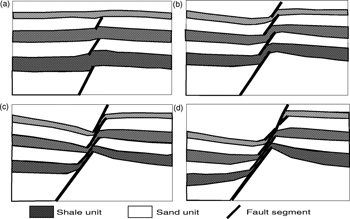| |||||||
|
|
|||||||
|
|
|||||||
| Faulting by Shale Smearing | |||||||
|
Shale smearing refers to the process of incorporation and attenuation of shale into the fault zone accompanying normal faulting. The product of this process is called shale or clay smearing. For a recent review of the topic, please see Vrolijk et al. (2016). Shale smearing occurs by the deformation of alternating brittle and ductile (normally shale) layers. The fundamental cause of shale smear is that shale can behave in a ductile manner. If shale is not ductile when deformed, it will behave just like another rock type in a brittle deformation field. At the same token, though called shale smear, the same process can involve other ductile materials such as limestone, salt, and even chert, not necessarily shale. The contrast in the mechanical properties of these layers leads to differences in their reaction to deformation: shale behaving in a ductile manner while surrounding layers fail in a brittle manner. When a brittle fracture encounters a ductile layer (Figure 1a), there is an out-of-plane offset across the ductile layer. The magnitude of the offset or more precisely step, is dependent on the thickness of the ductile layer. For detailed discussion about offset across ductile layers, please see 'Growth of Joints across Brittle Ductile Interlayers.' The offset in an extensional normal faulting environment allows shale to be incorporated into the fault zone (Figure 1b). So, shale smearing occurs only in extensional relays. This will also lead to abrupt discrete separation of the fault segments within brittle layers. Shale in the fault zone is stretched parallel to the fault and thins perpendicular to the fault as slip increases (Figure 1c) until a critical point where the continuity of the shale in the fault zone breaks down (Figure 1d). In multiple brittle and ductile sequences (Figure 2), when the vertical component of the fault slip exceeds the thickness of a brittle layer, the shale above and below the brittle layer will be in physical contact. Thus, the smeared shales from different units merge together forming a composite fault rock along the fault relay. Once different smeared shales merge, the composite fault rock behaves in a manner similar to that of a single shale smear. | |||||||
| Reference: |
|||||||
| Aydin, A., Eyal, Y., 2002 Eichhubl, P., D'Onfro, P.S., Aydin, A., Waters, J., McCarty, D.K., 2005 Koledoye, B., Aydin, A., May, E., 2003 Vrolijk, P., Urai, J.L., Kettermann, M., 2016 Yielding, G., Freeman, B., Needham, T., 1997 Younes, A.I., Aydin, A., 1998 |
|||||||
|
Readme | About Us | Acknowledgement | How to Cite | Terms of Use | Ⓒ Rock Fracture Knowledgebase |
|||||||

